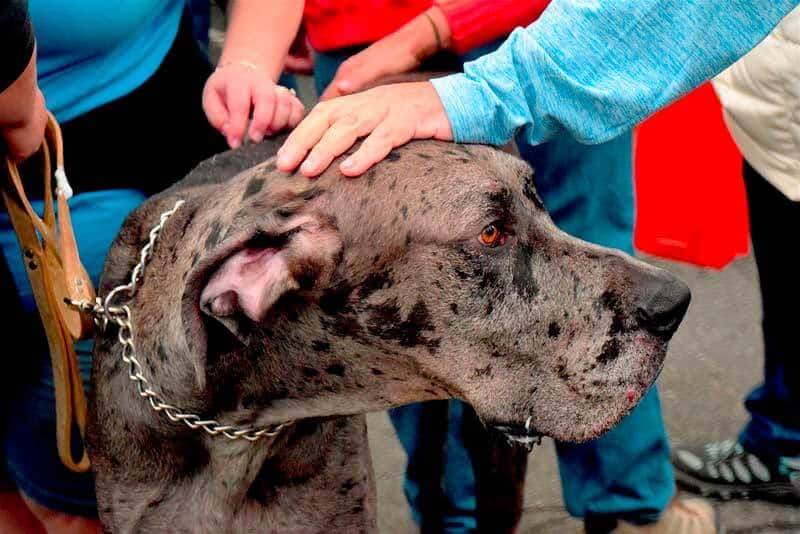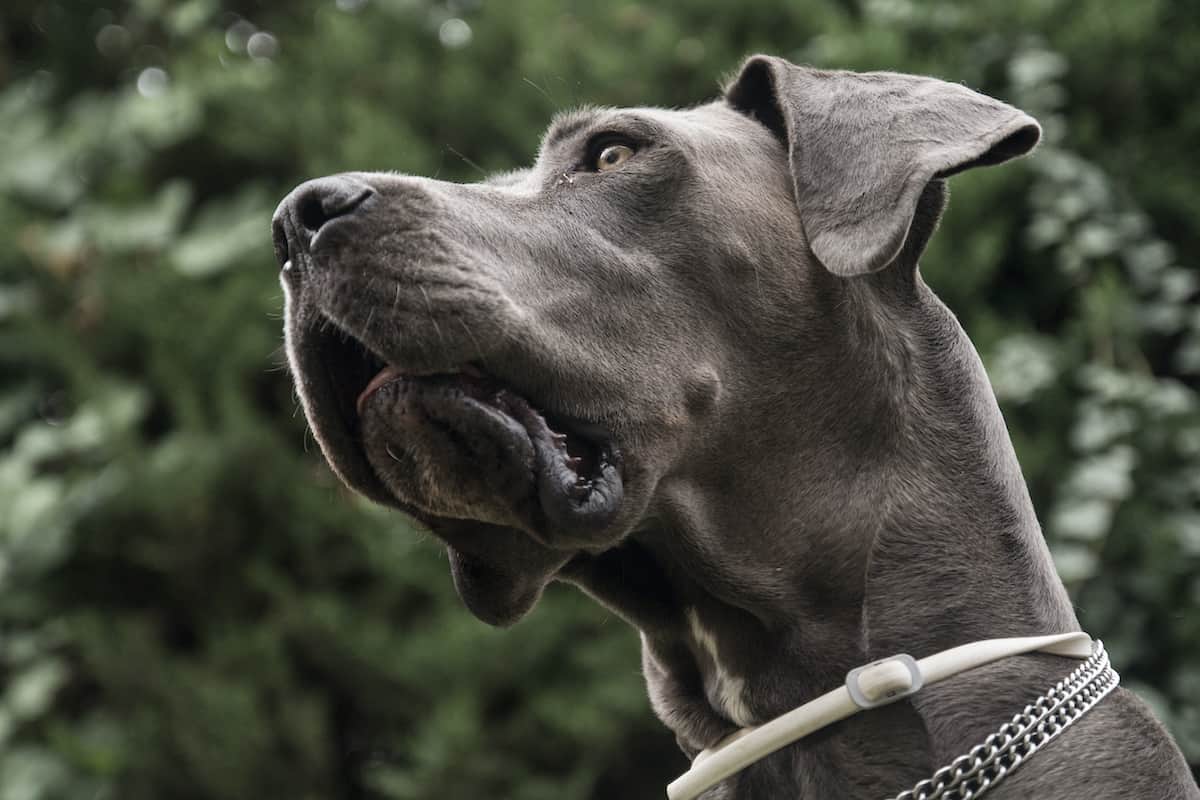
As a Great Dane owner, you should be aware that Great Danes could develop a condition that is commonly known as Wobbler’s Syndrome. Approximately 4.2% of Great Danes are diagnosed with this serious condition. Most of them are three years old or younger when they begin showing symptoms.
Wobbler’s Syndrome is a condition in which the cervical spinal cord, the part located in the neck, is compressed. Dogs suffering from it have difficulty walking and sometimes experience severe neck pain. Wobbler’s Syndrome is a serious issue, and it can eventually result in complete paralysis.
It’s actually a symptom of several different issues, rather than a specific disease. There are various technical terms used to describe it, but the most common one is cervical spondylomyelopathy or CSM. It can also be called cervical vertebral instability (CVI) and cervical vertebral malformation (CVM).
It is important to be aware of health problems that your dog is predisposed to because of its breed. The more you know about potential issues, the sooner you will recognize possible symptoms.
You can also be proactive in preventing common illnesses and injuries by taking steps to reduce your dog’s risk.
Symptoms & Signs of Wobbler’s Syndrome

Wobbler’s Syndrome gets its name from the wobbly or clumsy gait that affected dogs usually display.
This phenomenon is typically seen in the back legs first, at the onset of the syndrome. Dogs with this condition often spread their legs out wide while standing or walking, trying to better their balance.
They may have a hard time walking on hard, slippery floors and often lose their balance when trying to turn. Because of these mobility issues, the toenails on their hind feet are constantly worn down.
As their condition worsens, it begins to affect their front legs as well. Their front legs will appear to be stiff, and they will begin taking shorter, choppier steps. Affected dogs sometimes have difficulty even standing as the syndrome progresses.
Dogs with Wobbler’s Syndrome frequently droop their heads because of neck pain and stiffness. Often, they will not allow their necks to be handled, and they may collapse if their neck is moved in an uncomfortable way.
The onset of Wobbler’s syndrome can be progressive or acute. Dogs who develop sudden or acute Wobbler’s syndrome tend to experience more severe neck pain. An acute onset is usually the result of injury and is typically seen in Great Danes who are middle-aged and older.
Wobbler’s syndrome can eventually lead to complete or partial paralysis for about 5% of affected dogs. However, even without paralysis, Wobbler’s syndrome can be an incredibly debilitating condition.
The sooner it is diagnosed, the better your dog’s chances of recovery and quality of life will be.
What Causes Wobbler’s Syndrome?
There are many different theories as to what actually causes Wobbler’s syndrome, but there is no definite answer yet.
- Older dogs may suffer from spinal cord compression due to herniated discs or other age-related, degenerative spine issues.
- However, there is no obvious cause for the narrowing of the vertebral canal that leads to Wobbler’s syndrome in young dogs.
It has been suggested that a poor diet or excess of certain nutrients can lead to Wobbler’s syndrome. Owners often add unnecessary supplements to their dogs’ food, and too much protein or calcium can be detrimental.
The fast growth of giant breeds may be a cause as well, and this can be worsened by overfeeding or over-supplementing.
Predisposition to the condition is most likely hereditary since multiple cases are often seen within Great Dane families. However, this may simply be the result of litters being kept in the same environment under the same conditions.
There is not enough evidence yet to determine whether the condition develops through nature or nurture. Likely, it is a combination of both.
How Is Wobbler’s Syndrome Diagnosed?
Your veterinarian will start by giving your dog a complete physical exam to determine the probable cause of his symptoms. The exam will allow them to determine whether your dog’s symptoms are caused by a neck or neurological issue.
The second step will likely be an x-ray to rule out other conditions that can cause similar symptoms.
If no other causes are found, an MRI will be used to make a definite diagnosis of Wobbler’s syndrome. A CAT scan can be used to diagnose Wobbler’s Syndrome, but an MRI is a better test.
MRI’s have not been shown to have any negative effects on dogs, and the test results will give a clearer diagnosis. Your dog’s MRI will likely be done at a large animal hospital, rather than at your veterinarian’s office.
There is an older test called a myelogram that was once frequently used to diagnose Wobbler’s syndrome. With this test, a dye is injected around the affected area of the spinal cord and an x-ray is taken.
However, myelograms are far less clear than an MRI or CAT scan and often make neurological symptoms temporarily worse. While potentially cheaper, this is the more dangerous option, and it will not give a clear picture of your dog’s condition.
What are the Treatment Options?
There are both medical and surgical treatment options for dogs suffering from Wobbler’s Syndrome. Veterinarians will typically try to resolve the symptoms through medication before resorting to surgery.
Many dogs are successfully treated with medication and therapy alone. For others, however, surgery is a necessity.
Unfortunately, treatment and recovery is usually a long and expensive process. Your dog will likely remain on bed rest or have restricted activity for several months, in conjunction with physical therapy.
Treatment costs for both medical and surgical options typically range from about $3,000 up to $8,000.
Medical Treatments
Anti-inflammatory medications, such as corticosteroids, are often given to relieve some of the compression. Affected dogs are usually confined to a crate during treatment, and their activity must be extremely limited.
They may also be fitted with a neck brace or wrap to immobilize their cervical spine. The goal is to rest the neck as much as possible to reduce inflammation and compression.
A corticosteroid and rest regimen has been shown to provide many dogs with immense relief.
Acupuncture is a promising alternative treatment that can be used along with medication and rest. Electro-acupuncture has been shown to help relieve spinal cord compression in many dogs, with no reported negative side effects.
There is also evidence that gold bead implantation, a permanent acupuncture treatment, can provide additional relief. Aquatic physical therapy and laser treatments are also valid options for treating Wobbler’s syndrome.
Studies show that around 50% of dogs respond well to medical treatment alone and do not require surgery. Of the other half, 30% stay the same and 20% get worse. The average lifespan after successful treatment, either medical or surgical, is usually around four years.
Surgical Treatments
There are many different types of surgical approaches used to treat Wobbler’s Syndrome. Your veterinary surgeon will consider several factors, including the severity of your dog’s symptoms, when determining the best methods to use.
They will inform you of the various options and the pros and cons of each. Together, you will determine the best solution for your dog’s condition.
Approximately 80% of dogs treated surgically successfully recover from Wobbler’s Syndrome. However, physical therapy must be used after the operation to ensure that your dog does not experience muscle loss or atrophy.
Therapy will also help to prevent bone fusion and will speed up healing time. Your veterinarian may give you therapy exercises to do at home to help your dog recover faster and more efficiently.
Gold Bead Implants
Although not as common, another alternative treatment for Wobbler’s performed by a small number of veterinarians involves the use of gold bead implants. The gold beads are precisely inserted using a needle, and act to prevent excessive movement of the vertebrae in the cervical portion of the neck.
In addition to limiting excessive movement, the gold also helps to reduce inflammation of the spinal cord and leads to bone remodeling in the surrounding vertebrae.
While not commonly performed, there are many reported cases of positive outcomes for treating Wobbler’s using gold bead implants. For additional background on the scientific basis for using gold beads, please take a look at this article.
Life After Treatment
According to the College of Veterinary Medicine at Ohio State University, dogs with Wobbler’s have an average lifespan of 4 years. Sadly, this is the case whether or not they receive surgical treatment.
Both medical and surgical treatment of Wobbler’s syndrome must be accompanied by lifestyle changes to keep the condition from returning or worsening.
Affected dogs need to be switched to a chest harness to prevent additional stress or damage to the neck. Raised food and water bowls should also be used so that your dog does put unnecessary strain on his neck.
Although a nutritionally imbalanced diet is not a definitively proven cause of Wobbler’s syndrome, changes may still be recommended.
Your vet might suggest switching to a food with fewer calories and less protein to minimize risk. You should also discontinue using any supplements, especially those containing additional calcium unless your veterinarian says otherwise.
Post-treatment dogs will be on limited activity for at least a few months. Strenuous motions, such as running and jumping, should not be permitted.
You should take these lifestyle changes into consideration when deciding on a treatment option. Make plans for how you will care for your dog while he is confined and his activity is limited.
Younger dogs and those diagnosed and treated early typically have better outcomes than older dogs or advanced cases. However, many times the condition is not fully resolved, only lessened.
You will have to keep a watchful eye on your dog after treatment and act quickly if symptoms return. Wobbler’s syndrome is a serious condition, but with successful treatment, your dog can still have a good quality of life.

Should I continue to take my dane for walks after being diagnosed with Wobblers Syndrome
Barbara l walk my dane as much as l can in te surf and let the waves beat against his legs as directed by the chiropractor. Also massage legs against fur as often as you can and rub bottom of paws with a toothbrush for stimulation My dane is 7 years old thus did not opt for surgical intrvention
My great dane 7 years old diagnosed with Wobblers and is successfully being treated with Acupuncture, Chiropractic and Cold Laser. Takes Gabapentin one twice a day and l have reduced Loxicalm to 3ml per day. Will continue to try and eliminate medications as we go. Results have been promising so far.I also walk him in the surf as much as l can and massage his legs against the fur and rub the bottom of his pas with a toothbrush for stimulation